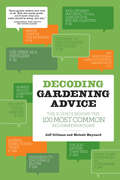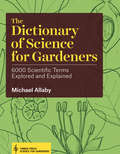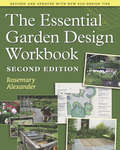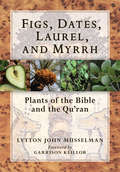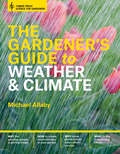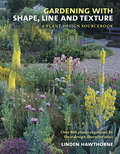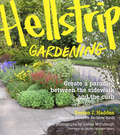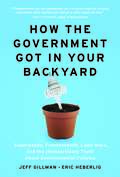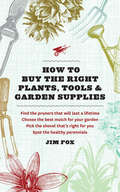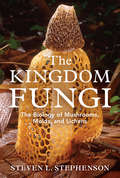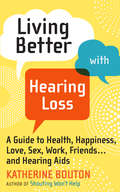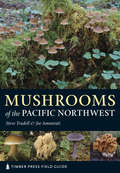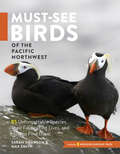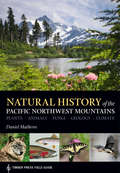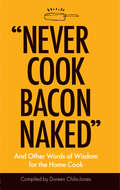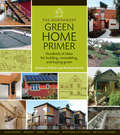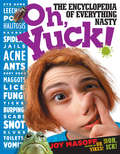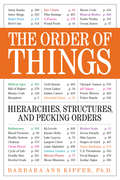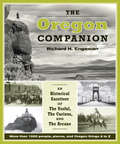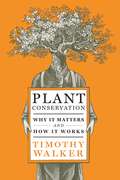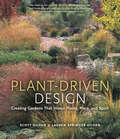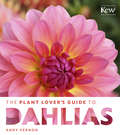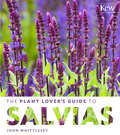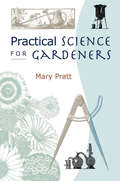- Table View
- List View
Decoding Gardening Advice: The Science Behind the 100 Most Common Recommendations
by Jeff Gillman Meleah MaynardCovering more than 100 universal gardening "dos and don'ts," Decoding Gardening Advice is the first book to provide gardeners with the real answers. Jeff Gillman, the bestselling author of The Truth About Garden Remedies, and Meleah Maynard back up every good recommendation with sound horticultural and botanical science. Decoding Gardening Advice is the first and only hard-hitting, evidence-based book that every gardener needs for definitive advice on everything from bulbs, annuals, and perennials to edibles, trees, and soil care.
The Dictionary of Science for Gardeners: 6000 Scientific Terms Explored and Explained (Science For Gardeners Ser.)
by Michael AllabyA Library Journal Best Reference Pick of 2015! Every gardener is a scientist. Pollination, native plants, ecology, climatology—these are just a few of the scientific concepts that play a key role in a successful garden. While the ideas are intuitive to many gardeners, they are often discussed in unfamiliar scientific terms. The Dictionary of Science for Gardeners is the first of its kind to provide practical scientific descriptions for gardening terms. Highlighting 16 branches of science that are of particular interest to gardeners, with entries from abaptation to zoochory, Michael Allaby explores more than 6,000 terms in one easy-to-use reference.
The Essential Garden Design Workbook: Third Edition
by Rosemary AlexanderThe Essential Garden Design Workbook guides the reader through every stage of planning a garden — how to survey a site, how to choose landscaping materials, and how to develop planting schemes. This fully revised and updated second edition features new U.S. case studies and new photographs. Valuable tips on green gardening are new to this edition, and include how to harvest rainwater, how to design a green roof, tips on sustainable planting, and a guide to composting. Tailor-made for hands-on gardeners, the workbook approach is accessible, practical, and can be used to create a garden from scratch and to redesign an existing garden. Gardeners will find easy ways to measure large spaces, estimate the height of a tree, and find the right proportions for a deck. They'll also find tips on space, light, and color. Includes hundreds of easy-to-follow line drawings and diagrams.
Figs, Dates, Laurel, and Myrrh: Plants of the Bible and the Quran
by Lytton John Musselman Garrison KeillorThis book celebrates the plants of the Old Testament and New Testament, including the Apocrypha, and of the Quran. From acacia, the wood of the tabernacle, to wormwood, whose bitter leaves cured intestinal worms, 81 fascinating chapters—covering every plant that has a true botanical counterpart—tell the stories of the fruits and grains, grasses and trees, flowers and fragrances of ancient lore. The descriptions include the plants' botanical characteristics, habitat, uses, and literary context. With evocative quotations and revelatory interpretations, this information is all the more critical today as the traditional agrarian societies that knew the plants intimately become urbanized.The unusually broad geographic range of this volume extends beyond Israel to encompass the Holy Land's biblical neighbors from southern Turkey to central Sudan and from Cyprus to the Iraq border.Richly illustrated with extensive color photography and with a foreword by the incomparable Garrison Keillor, this delightful ecumenical botany offers the welcome tonic of a deep look into an enduring, shared natural heritage.
The Gardener's Guide to Weather and Climate: How to Understand the Weather and Make It Work for You (Science For Gardeners Ser.)
by Michael Allaby“We owe it to our plants to read this book. After all, while we just live with the weather, our plants have to survive it.” —The Washington Post All gardeners are at the whim of Mother Nature, and so are our plants. Whether it’s coping with extreme drought or record-breaking snow fall, gardeners—and gardens—across the country are fighting against the elements. Instead of just reacting to the weather, Michael Allaby suggests that gardeners use knowledge about how the weather works to create the best growing conditions for their plants. Allaby brings big-picture atmospheric concepts to life with a comprehensive introduction to how weather works and explanations climate change, weather systems, and microclimates. The Gardener’s Guide to Weather and Climate proves that instead of gardening at the mercy of the weather, knowledgeable gardeners can make the weather work for them
Gardening with Shape, Line and Texture: A Plant Design Sourcebook
by Linden HawthorneGardening with Shape, Line and Texture bridges the gap between garden design books and plant reference encyclopedias. Leading landscaper Linden Hawthorne looks at plants from a designer's perspective (where color is often a secondary consideration) and emphasizes the important roles of plant shape. Part One reviews fine art principles and shows how they can be successfully applied to plant compositions by grouping plants into three heights: ground to knee, knee to navel, and navel to crown. She identifies different plant shapes—buns, mounds, tiers, fountains, uprights—and shows how the use of them contributes to the success of the finished design. Part Two is a plant sourcebook with plants listed alphabetically within their key plant shape categories. This innovative plant reference delivers plant information in a form that neatly dovetails with the garden design process and will inspire gardeners to look beyond color and begin to appreciate the whole plant.
Hellstrip Gardening: Create a Paradise between the Sidewalk and the Curb
by Evelyn Hadden Joshua McCulloughThe hellstrip—also known as a boulevard, meridian, and planting strip—is finally getting the attention it deserves! Gardeners everywhere are taking advantage of the space to add curb appeal to their homes, expand the size of their gardens, and conserve more resources. Hellstrip Gardening is the first book to show you exactly how to reclaim these oft-ignored spaces by determining the city and home owner's association rules, choosing plants that thrive in tough situations, designing pathways for accessibility, and much more. Gorgeous color photographs of hellstrip gardens across the country offer inspiration and visual guidance to anyone ready to tackle this final frontier.
How the Government Got in Your Backyard: Superweeds, Frankenfoods, Lawn Wars, and the (Nonpartisan) Truth About Environmental Policies
by Jeff Gillman Eric HeberligBiotechnology—the future or a genetic time bomb? Renewable fuels—the key to cleaner air or just corporate welfare? Greenhouse gasses—baking the earth to death or just a needless worry? Plant patents—improving gardens and farms or just profiteering? When you stop to think about it, the government has its hand in every important environmental issue. And with the left and the right raucously disagreeing about whether the government’s policies are for good or for evil, it’s impossible for a concerned citizen to know what to think.How the Government Got in Your Backyard distills the science, the politics, and the unbiased, nonpartisan truth behind hot-button environmental issues from pesticides to global warming. By clearly representing what the left says, what the right says, what the science is, and what the facts are, Gillman and Heberlig don’t set out to provide the answer—they light the path so concerned citizens can uncover their own true and informed opinion. In this season of political discontent, the unbiased truth about environmental policies—free of political agendas—is as refreshing as it is fascinating.How the Government Got in Your Backyard is not for Republicans or Democrats, liberals or conservatives. It’s for anyone who is ready to get to the bottom line.
How to Buy the Right Plants, Tools, and Garden Supplies: Find The Pruners That Will Last A Lifetime Choose The Best Mulch For Your Garden Pick The Shovel That's Right For You Spot The Healthy Perennials
by Jim FoxAre you confused by all the choices when you visit a nursery? Do you get sticker shock when you see how much that nice little shade tree costs? Let Jim Fox, a nursery professional with over twenty years of experience, show you how to become a savvy garden consumer and get the most for your hard-earned landscaping dollars. <P><P>How to Buy the Right Plants, Tools, and Garden Supplies will arm you with a wealth of knowledge! You’ll learn how to determine if a plant is healthy, how to choose the right size, how to correctly read the plant tag, how to choose the best tools and supplies for your needs, and how to confidently recognize a well-made tool. <P><P> In addition to helping you navigate the nursery, it tells you what you need to know before you get there and offers helpful tips on how to successfully garden once you get home.With this essential guide in hand, you’ll never experience buyer’s remorse again!
The Kingdom Fungi: The Biology of Mushrooms, Molds, and Lichens
by Steven L. StephensonThe ubiquitous fungi are little known and vastly underappreciated. Yet, without them we wouldn’t have bread, alcohol, cheese, tofu, or the unique flavors of mushrooms, morels, and truffles. We can’t survive without fungi. The Kingdom Fungi provides a comprehensive look at the biology, structure, and morphological diversity of these necessary organisms. It sheds light on their ecologically important roles in nature, their fascinating relationships with people, plants, and animals, and their practical applications in the manufacture of food, beverages, and pharmaceuticals. The book includes information about “true” fungi, fungus-like creatures (slime molds and water molds), and a group of “composite” organisms (lichens) that are more than just fungi. Particular attention is given to examples of fungi that might be found in the home and encountered in nature. The Kingdom Fungi is a useful introductory text for naturalists, mycologists, and anyone who wants to become more familiar with, and more appreciative of, the fascinating world of fungi.
Living Better with Hearing Loss: A Guide to Health, Happiness, Love, Sex, Work, Friends . . . and Hearing Aids
by Katherine BoutonMore than 48 million Americans suffer from hearing loss, and audiologists agree this is a national epidemic. LIVING BETTER WITH HEARING LOSS is a practical guide to daily life with hearing loss, covering topics from hearing tests and buying (and paying for) hearing aids, to deciding whether to get a cochlear implant, to navigating airports, job interviews, and first dates when you suffer from hearing loss. Useful and readable for the newly hearing-impaired, those who have been struggling for years, and their families. Author Katherine Bouton has also written Shouting Won't Help, a memoir of her adult-onset hearing loss.
Mushrooms of the Pacific Northwest: Timber Press Field Guide (A Timber Press Field Guide)
by Joe Ammirati Steve TrudellExplore the heart of mushroom country The Pacific Northwest is one of the best places to find mushrooms—they are both abundant and spectacularly diverse. Yet until now, there has been no mushroom guide that focuses on the region. This compact, beautifully illustrated guide presents descriptions and photographs of 460 of the region's mushrooms. In addition to profiles on individual species, Mushrooms of the Pacific Northwest also includes a general discussion and definition of fungi, information on where to find mushrooms and guidelines on collecting them, an overview of fungus ecology, and a discussion on how to avoid mushroom poisoning.
Must-See Birds of the Pacific Northwest: 85 Unforgettable Species, Their Fascinating Lives, and How to Find Them
by Sarah Swanson Max SmithMust-See Birds of the Pacific Northwest is a lively, practical guide that helps readers discover 85 of the region’s most extraordinary birds. Each bird profile includes notes on what they eat, where they migrate from, and where to find them in Washington and Oregon. Profiles also include stunning color photographs of each bird. Birds are grouped by what they are known for or where they are most likely to be found—like beach birds, urban birds, colorful birds, and killer birds. This is an accessible guide for casual birders, weekend warriors, and families looking for an outdoor experience. Eight easy-going birding weekends, including stops in Puget Sound, the Central Washington wine country, and the Klamath Basin, offer wonderful getaway ideas and make this a must-have guide for locals and visitors alike.
Natural History of the Pacific Northwest Mountains: Timber Press Field Guide (A Timber Press Field Guide)
by Daniel MathewsNatural History of the Pacific Northwest Mountains is an engagingly written, portable history and identification guide for the flora, fauna, and geology of the region. This guide also includes information about the landscape and weather. Packed with 800 color photographs, this is the perfect overview of the Pacific Northwest if you are looking for a simple way to discover the great outdoors.
“Never Cook Bacon Naked”: And Other Words of Wisdom for the Home Cook
by Doreen Chila-JonesWe have all done it: ruined an entire dinner; burned a piece of toast; served raw chicken to our guests. Cooking can be a daunting, frustrating, and hopeless pursuit . . . and when you are in a pickle, it's time for a little pep talk from some of the biggest cooking and non-cooking experts—people like Julia Child, Thomas Keller, Alice Waters, Truman Capote, Maya Angelou, and many others who, at one time or another, have also scorched their lunch. But remember, as the cookbook author Alana Chernila likes to say, “Homemade food is the opposite of perfection.”
The Northwest Green Home Primer
by Kathleen Smith Kathleen O'BrienThe essential, real-world, green home manual Everyone can make green home decisions on a budget with this inspiring, informationpacked guide. Whether you are building, remodeling, buying, or just curious, here are real-world strategies for getting the greenest results from your budget, with hundreds of ideas for a home that is built to last, comfortable and healthy, money- and time-saving in the long term, and kind to the planet. From your home's exterior to its operating systems within, from siting to interior design, this is the basic training that has given many the confidence to proceed. Award-winning sustainable design and building consultant and teacher Kathleen O'Brien and architectural designer and sustainability consultant Kathleen Smith offer their "top picks" for each phase. They've also each faced their own green home challenges in a single-family house and a duplex, and other case studies show affordable energy-efficient green homes both old and new. Brimming with ideas, clear and logical, with tips, checklists, and resources for green home planning, construction, remodeling, and maintenance, extensively illustrated with photos and diagrams, this is the essential green home manual for novice and professional alike.
Oh, Yikes!: History's Grossest, Wackiest Moments
by Joy MasoffGross is back and viler than ever! From the author of Oh, Yuck! the perennial bestseller about science with over 610,000 copies in print, comes OH, YIKES!, an illustrated encyclopedia of history’s messiest, dumbest, grossest, wackiest, and weirdest moments. If kids think pus and gas are fun, wait until they hear the lowdown on the real Dracula, samurai, gladiators, guillotines and vomitoriums, pirates, Vikings, witch trials, and the world’s poxiest plagues. Impeccably researched, deliciously wry, and subversively educational (check out the toilet-paper timeline), OH, YIKES! covers people, events, institutions, and really bad ideas, alphabetically from April Fool’s Day to zany Zoos. Here are the Aztecs, sacrificing 250,000 people a year for the gods—and for food. Fearsome Attila the Hun, scourge of the steppes whose spinning eyes terrified his friends and whose mastery of horses terrorized his enemies (how does someone so evil die? Nosebleed!). Saur, the 11th-century dog-king of Norway (and not too bad as kings go). Henry VIII and his marital problems, the story of the Abominable Snowman and the Loch Ness Monster, why sailors in the old days preferred eating in the dark (hint: you can’t see what’s crawling in your food), and the answer to the question, “How did knights in armor go to the bathroom?” Topped off with hundreds of illustrations and photographs along with hands-on activities that bring the past to life, OH, YIKES! puts the juice in history in a way that makes it irresistible.
Oh, Yuck!: The Encyclopedia of Everything Nasty
by Joy MasoffKids love stuff that's gross. From the liquids, solids, and gases--especially the gases!--or their own bodies to the creepy, crawly, slimy, slithery, fetid, and feculent phenomena in the world at large, kids with a curious bent just can't get enough. Oh, Yuck! The Encyclopedia of Everything Nasty brings together, in one book, all the good things about some of the baddest things on Earth.Exhaustively researched and impeccably scientific, yet written with a lively lack of earnestness, Oh, Yuck! is an ants to zits encyclopedic compendium covering people, animals, insects, plants, foods, and more. Here are vampire bats, which sip blood and pee at the same time so that they'll always be light enough to fly away; and slime eels, wreathed in mucus and eating fellow fish from the inside out. Oh, Yuck! explains why vomit smells; where dandruff comes from; what pus is all about; and why maggots adore rotting meant. Other features include gross recipes, putrid projects, 10 foods that make you airborne, and more.With hundreds of cartoon illustrations and real-life photographs, Oh, Yuck! is the complete guide to the irresistible--at least to an 8-to-12 year old--underbelly of life.
The Order of Things: Hierarchies, Structures, and Pecking Orders
by Barbara Ann KipferUtterly compelling! Barbara Ann Kipfer has elevated the list to high art and bestselling pleasure. A foremost expert of classification, in The Order of Things, she does for life what her previous books do for happiness and wisdom—organize it in a way that is brilliantly conceived. The The Order of Things is practical, entertaining, eclectic, and impossible to put down. Beginning with Earth—Smog Alert States, Rain Forest Layers, Coal Sizes— and ending with General Knowledge and Philosophy (the I Ching's 64 "chapters," Ludwig Wittgenstein's four-step Method of Overcoming Puzzlement), it is a 14-chapter taxonomy of the world as we know it: • The Seven Hills of Rome, the Seven Deadly Sins, the Seven Wonders of the Ancient World, the Seven Dwarfs—check. • The belt degrees of karate and judo, weight classes of professional and amateur boxing, flower names of the golf holes at Augusta—check. • The hierarchy of the FBI, publication order of Shakespeare's plays, cuts of beef, Freud's divisions of the human psyche, order of rank in world armies and navies, Jupiter's satellites, ships' bells, traditional and modern wine measures, blood-pressure levels, fastest animals—check. A completely indispensable reference—check.
The Oregon Companion: An Historical Gazetteer of the Useful, the Curious, and the Arcane
by Richard H. EngemanWhat's the connection between Ken Kesey and Nancy's Yogurt? How about the difference between a hoedad and a webfoot? What became of the Pixie Kitchen and the vanished Lambert Gardens?The Oregon Companion is an A–Z handbook of over 1000 people, places, and things. From Abernethy and beaver money to houseboats, railroads, and the Zigzag River, an intrepid public historian separates fact from fiction — with his sense of humor intact. Entries include towns and cities, counties, rivers, lakes, and mountains; people who have left a mark on Oregon; industries, products, crops, and natural resources. Includes more than 160 historical black and white photos. This entertaining and delightfully meticulous compendium is an essential reference for anyone curious about Oregon.
Plant Conservation: Why It Matters and How It Works
by Timothy WalkerPlants’ ability to turn sunlight into energy makes them the basis for all life; without them there is no life. And they are more than just a food source—they provide us with fuel, fibers, and pharmaceuticals. Global warming and the destruction of natural habitats are a serious threat to many plants, and there are worldwide efforts to mitigate the disaster. Plant Conservation tackles this essential topic head on. Timothy Walker, as the director of the Oxford Botanical Garden, a leader in the field of plant conservation, plays a key role in this effort. He highlights what is happening now, from cataloging the world’s flora to conservation efforts like protecting plants from overcollecting. He also shows home gardeners how they can become involved, whether by growing their own food to decrease reliance on large agriculture or by making smart plant choices by growing natives and avoiding invasives. Plant Conservation treats a critical topic in an accessible and optimistic way. It is required reading for students, professionals, and anyone with a keen interest in the importance of plants.
Plant-Driven Design: Creating Gardens That Honor Plants, Place, and Spirit
by Scott Ogden Lauren Springer OgdenFor too long, garden design has given pride of place to architecture, artifice, and arbitrary principles. The results? Soulless landscapes where plants play subordinate roles.With passion and eloquence, Scott Ogden and Lauren Springer Ogden argue that only when plants are given the respect they deserve does a garden become emotionally resonant. Plant-Driven Design shows designers how to work more confidently with plants, and gives gardeners more confidence to design. The Ogdens boldly challenge design orthodoxy and current trends by examining how to marry plantsmanship and design without sacrificing one to the other.Supported by extensive lists of plants adapted to specific purposes and sites, Plant-Driven Design explores how plants interact with place. In addition, the authors' experience gardening and designing in a wide variety of climates gives their perspective a unique depth. In ideas, scope, and detail, this book both embraces and transcends regionality. By reclaiming gardens as a home to plants, this groundbreaking work will restore life-affirming vitality to garden design and profoundly affect how we understand and experience gardens.
The Plant Lover's Guide to Dahlias (The Plant Lover’s Guides)
by Andy VernonDahlias are the showgirls of the garden. A favorite of floral and landscape designers, they come in a wide range of jewel-like colors—rich reds and vibrant oranges, shocking pinks—and an engaging variation of form and petal shape. The Plant Lover’s Guide to Dahlias is packed with everything you need to know to grow these fantastic flowers including tips on using dahlias in garden design, growth and propagation information, and lists of where to buy the plants and where to view them in public gardens. The bulk of the book is devoted to profiles for over 200 varieties, organized by color, with information on type, height, and spread. Gorgeous color photographs bring the plants to life.
The Plant Lover's Guide to Salvias (The Plant Lover’s Guides)
by John WhittleseySalvias are available in a huge range of sizes, colors, foliage, and hardiness, with over 900 species and hundreds of hybrids. Salvia’s popularity stems from how easy they are to grow, their multiple medicinal and culinary uses, and the vibrancy of their blooms that cover every color in the spectrum from white to nearly black. The Plant Lover’s Guide to Salvias features everything you need to know to grow this vibrant and fragrant plant. Plant profiles of 150 varieties highlight each plant’s type, habitat, size, hardiness, origin, cultivation, and use in the landscape. Additional information includes tips on design, how to grow and propagate salvia, where to view them in public gardens, and where to buy them.
Practical Science for Gardeners
by Mary PrattInformative and entertaining, this book will stimulate experimentation and encourage gardeners to review and improve their current gardening practices. Once gardeners learn how plants are constructed, it is easier to envision how they'll grow and flourish. An understanding of the structure behind good, healthy soil gives clues as to how to improve one's own garden tilth. This practical guide helps readers identify what plants need to survive and how these fundamental scientific facts are at the heart of good plant care. A chapter on seeds and germination will encourage gardeners at any level to try their hand at propagation, while discussion of soil, pests, and diseases adds to the skills of all gardeners. The final sections of the book take a closer look at biodiversity, ecology, genetic engineering, and nomenclature. For the enthusiastic beginner or the master gardener, Practical Science for Gardeners unravels the mysterious inner life of plants.
